
A bead is a small, decorative object that is formed in a variety of shapes and sizes of a material such as stone, bone, shell, glass, plastic, wood, or pearl and with a small hole for threading or stringing. Beads range in size from under 1 millimetre (0.039 in) to over 1 centimetre (0.39 in) in diameter.

Lindisfarne, also called Holy Island, is a tidal island off the northeast coast of England, which constitutes the civil parish of Holy Island in Northumberland. Holy Island has a recorded history from the 6th century AD; it was an important centre of Celtic Christianity under Saints Aidan, Cuthbert, Eadfrith, and Eadberht of Lindisfarne. The island was originally home to a monastery, which was destroyed during the Viking invasions but re-established as a priory following the Norman Conquest of England. Other notable sites built on the island are St. Mary the Virgin parish church, Lindisfarne Castle, several lighthouses and other navigational markers, and a complex network of lime kilns. In the present day, the island is an Area of Outstanding Natural Beauty and a hotspot for historical tourism and bird watching. As of February 2020, the island had three pubs, a hotel and a post office.

Cuthbert of Lindisfarne was an Anglo-Saxon saint of the early Northumbrian church in the Celtic tradition. He was a monk, bishop and hermit, associated with the monasteries of Melrose and Lindisfarne in the Kingdom of Northumbria, today in north-eastern England and south-eastern Scotland. Both during his life and after his death, he became a popular medieval saint of Northern England, with a cult centred on his tomb at Durham Cathedral. Cuthbert is regarded as the patron saint of Northumbria. His feast days are 20 March and 4 September.

Crinoids are marine invertebrates that make up the class Crinoidea. Crinoids that are attached to the sea bottom by a stalk in their juvenile form are commonly called sea lilies, while the unstalked forms, called feather stars or comatulids, are members of the largest crinoid order, Comatulida. Crinoids are echinoderms in the phylum Echinodermata, which also includes the starfish, brittle stars, sea urchins and sea cucumbers. They live in both shallow water and in depths as great as 9,000 meters (30,000 ft).

The Lindisfarne Gospels is an illuminated manuscript gospel book probably produced around the years 715–720 in the monastery at Lindisfarne, off the coast of Northumberland, which is now in the British Library in London. The manuscript is one of the finest works in the unique style of Hiberno-Saxon or Insular art, combining Mediterranean, Anglo-Saxon and Celtic elements.

A necklace is an article of jewellery that is worn around the neck. Necklaces may have been one of the earliest types of adornment worn by humans. They often serve ceremonial, religious, magical, or funerary purposes and are also used as symbols of wealth and status, given that they are commonly made of precious metals and stones.

Hilda of Whitby was a saint of the early Church in Britain. She was the founder and first abbess of the monastery at Whitby which was chosen as the venue for the Synod of Whitby in 664. An important figure in the Christianisation of Anglo-Saxon England, she was abbess in several convents and recognised for the wisdom that drew kings to her for advice.
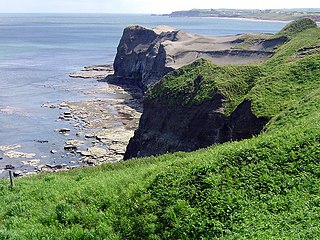
Sandsend Ness is an old alum quarrying site close to Whitby in North Yorkshire, England.

Eata, also known as Eata of Lindisfarne, was Bishop of Hexham from 678 until 681, and of then Bishop of Lindisfarne from before 681 until 685. He then was translated back to Hexham where he served until his death in 685 or 686. He was the first native of Northumbria to occupy the bishopric of Lindisfarne.

Saint Ælfflæd (654–714) was the daughter of King Oswiu of Northumbria and Eanflæd. She was abbess of Whitby Abbey, an abbey of nuns that were known for their skills in medicine, from the death of her kinswoman Hilda in 680, first jointly with her mother, then alone. Ælfflæd was particularly known for her skills in surgery and her personal attention to patients, as was Hilda, who was known for her personalized medical care.
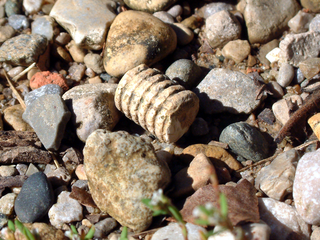
Indian bead is a colloquial American term for a fossilized stem segment of a columnal crinoid, a marine echinoderm of the class Crinoidea. The fossils, generally a centimeter or less in diameter, tend to be cylindrical with a small hole along the axis and can resemble unstrung beads. The fossils are abundant in certain areas, including parts of the American Midwest where they are present in gravel. They are sometimes also referred to as "Indian money".
Hartlepool Abbey, also known as Heretu Abbey, Hereteu Abbey, Heorthu Abbey or Herutey Abbey, was a Northumbrian monastery founded in 640 CE by Hieu, the first of the saintly recluses of Northumbria, and Aidan of Lindisfarne, on the Headland Estate of Hartlepool now called the Heugh or Old Hartlepool, in County Durham, England.
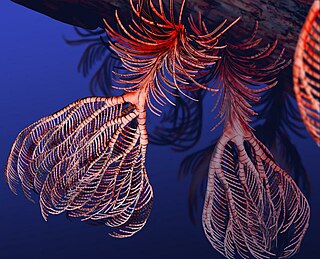
Pentacrinites is an extinct genus of crinoids that lived from the Hettangian to the Bathonian of Asia, Europe, North America, and New Zealand. Their stems are pentagonal to star-shaped in cross-section and are the most commonly preserved parts. Pentacrinites are commonly found in the Pentacrinites Bed of the Early Jurassic of Lyme Regis, Dorset, England. Pentacrinites can be recognized by the extensions all around the stem, which are long, unbranching, and of increasing length further down, the very small cup and 5 long freely branching arms.
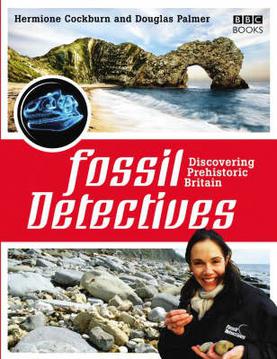
Fossil Detectives is a 2008 BBC Television documentary series in which presenter Hermione Cockburn travels across Great Britain exploring fossil sites and discovering the latest scientific developments in geology and palaeontology. The show is a spin-off of Coast.

Encrinus is an extinct genus of crinoids, and "one of the most famous". It lived during the Late Silurian-Late Triassic, and its fossils have been found in Europe.
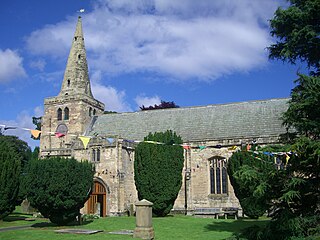
The Church of St Lawrence is situated in the village of Warkworth in Northumberland. It is a grade I listed building within the Diocese of Newcastle and dedicated to St Lawrence of Rome.

Bourgueticrinida is an order of crinoids that typically live deep in the ocean. Members of this order are attached to the seabed by a slender stalk and are known as sea lilies. While other groups of crinoids flourished during the Permian, bourgueticrinids along with other extant orders did not appear until the Triassic, following a mass extinction event in which nearly all crinoids died out.

Hildoceras bifrons is an extinct species of ammonite in the family Hildoceratidae. It dates from about 175 million years ago in the Early Jurassic when it was both widespread and common. Fossils have been found in North Africa and Europe, including several regions of England.

Northumbria, in modern contexts, usually refers to the region of England between the Tees and Tweed, including the historic counties of Northumberland and Durham, but it may also be taken to be synonymous with North East England. The area corresponds to the rump lands of the historical Kingdom of Northumbria, which later developed into the late medieval county of Northumberland or Comitatus Northumbriae, whose original southern boundary was the River Tees. A provincial flag of Northumbria has been registered.

Thalassodraco is an extinct genus of ophthalmosaurid ichthyosaur from the Late Jurassic (Tithonian) Kimmeridge Clay Formation of England. The type species, T. etchesi, was named in 2020, with the epithet in honour of the discoverer of the holotype, Steve Etches.



















